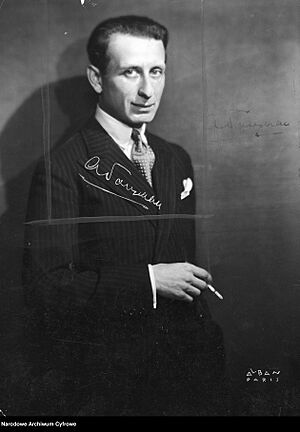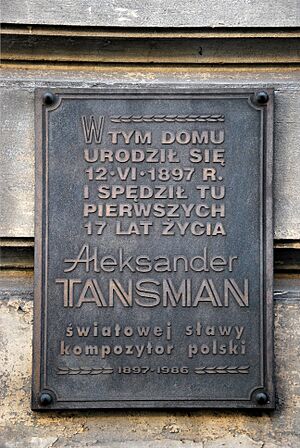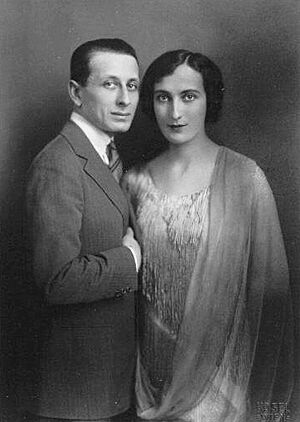Alexandre Tansman facts for kids
Alexander Tansman (Polish: Aleksander Tansman; born June 12, 1897 – died November 15, 1986) was a famous Polish composer, pianist, and conductor. He later became a French citizen in 1938. Tansman was one of the first composers to use a style called neoclassicism. He was also part of a group of international musicians known as the École de Paris. Tansman was well-known and celebrated around the world for his music.
Contents
Early Life and Beginnings
Tansman was born and grew up in Łódź, a city in Poland. His parents were from a Jewish background in Lithuania. His father passed away when Alexander was only 10 years old. His mother raised him and his older sister Teresa by herself.
Alexander started learning music at the Lodz Conservatory. But he also studied law at the University of Warsaw. On January 8, 1919, Tansman won the first music competition held in independent Poland. He then gave many concerts in Warsaw.
Musical Journey
In 1919, important musicians like Ignacy Jan Paderewski encouraged Tansman to move to Paris. In Paris, his musical ideas were liked and supported by famous composers such as Maurice Ravel and Igor Stravinsky. Even though some composers wanted him to join their group called Les Six, Tansman chose to stay independent.
He became a leading composer in the neoclassical style, alongside Stravinsky and others. He was also a respected member of the international music group École de Paris.
Rising to Fame
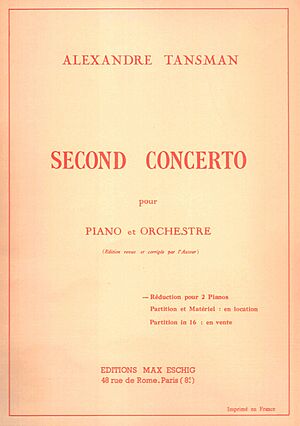
From the 1920s, Tansman became very famous. His music was performed by world-renowned conductors like Arturo Toscanini and Serge Koussevitzky. He was the second Polish composer to have a ballet, Sextuor, performed at the famous Metropolitan Opera in 1927.
In 1927, a music expert named Nicholas Slonimsky called Tansman "Poland's musical representative in the Western World." This shows how important Tansman was on the global music scene. His works were played in major concert halls around the world, like Carnegie Hall in New York and Salle Pleyel in Paris.
In 1931, a book about Tansman's music and style was published in Paris. It said that Tansman's music was a great tribute to his home country, Poland.
World Tour and Moving to America
In 1932–1933, Tansman went on an amazing world tour. He visited the United States, Japan, India, and Egypt. He was even honored by important figures like Mahatma Gandhi and Emperor Hirohito of Japan. In Tokyo, he became an honorary member of the Imperial Academy of Music.
In June 1938, Tansman became a French citizen. However, with Hitler's rise to power, Tansman's Jewish background put him in danger. His friend, the famous actor Charlie Chaplin, helped him get a visa to move to Los Angeles, USA. In 1941, he joined a group of famous artists and thinkers who had also moved there, including Igor Stravinsky and Thomas Mann.
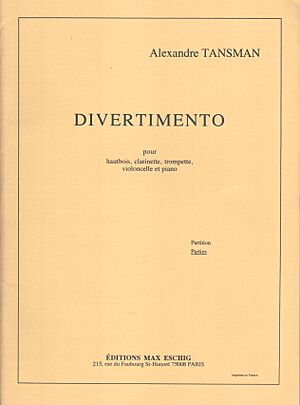
During his time in America, Tansman toured a lot as a pianist and conductor. He wrote many pieces, including symphonies and piano works. He also wrote music for a few Hollywood movies, like Flesh and Fantasy and Paris Underground. For Paris Underground, he was even nominated for an Oscar award in 1946 for Best Music. In 1948, Tansman wrote a book about his friend, Igor Stravinsky.
Return to Europe
In 1946, Tansman returned to Paris. His music career continued to grow across Europe. His works were performed by top orchestras and conductors, sometimes over 500 times a year. He also worked with famous choreographers for his ballets.
Tansman received many awards for his contributions to music. In 1966, he won the Hector Berlioz Prize. In 1978, he received the Music Prize from the French Academy. In 1986, he was given the highest honor, the Commander grade of the Ordre des Arts et des Lettres.
Alexander Tansman continued to live in France until his death in Paris in 1986. Since 1996, his hometown of Lodz has held the Alexander Tansman International Festival and Competition to celebrate his music.
Personal Life
Tansman's first wife was Anna E. Broçiner. They divorced in 1932. In 1934, he met Princess Nadejda de Bragança, and they were together until 1936. In 1937, he married Colette Cras, a well-known French pianist. They had two children together.
His Music Style
Tansman was not just a composer; he was also a brilliant pianist and conductor. He often performed as a pianist at famous venues like Carnegie Hall. He went on five concert tours in the United States.
Music experts say Tansman's music combined the French neoclassical style with the Polish national style from his homeland. He also used elements from his Jewish background and American dance music. He was influenced by composers like Maurice Ravel, who helped him learn to use musical elements wisely. Tansman also mentioned the influence of Béla Bartók and Arnold Schönberg.
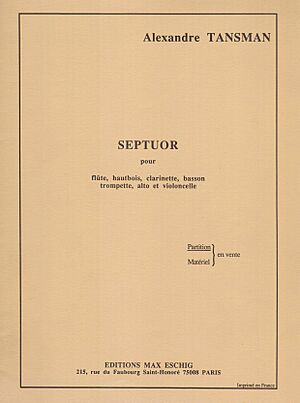
Tansman's music was known for its clear structure, elegant style, and rich melodies. He used a technique called polytonality (using more than one key at once) as early as 1916. Critics admired his skill in writing for orchestras and using counterpoint (combining different melodies). They even spoke of the "Tansman phenomenon" because of his unique musical language.
Tansman always saw himself as a Polish composer. He said, "It is obvious that I owe much to France, but anyone who has ever heard my compositions cannot have doubt that I have been, am and forever will be a Polish composer." Like Frédéric Chopin, Tansman often used traditional Polish forms like the mazurka and the polonaise in his music. He adapted Polish folk themes to create new and exciting sounds.

After World War II, Tansman began to use more modern and bold techniques in his music. He experimented with different sounds and rhythms, always aiming to create a new classical style.
Tansman wrote over 300 musical works! These include 7 operas, 10 ballets, 6 oratorios, and 9 symphonies. He also wrote many concertos, chamber music pieces, and works for piano and guitar. His guitar pieces, especially those written for Andrés Segovia, are still very popular today.

Many famous musicians have performed Tansman's works, including violinists Jascha Heifetz and cellists Pablo Casals. Almost all of his works have been recorded on CDs, so you can still listen to them today.
Selected Works
Alexander Tansman composed many pieces, including:
- Album polski (The Polish Album) for piano (1915–1916)
- Symphonie no. 1 (1916)
- String Quartet no. 1 (1917)
- Sonate no. 2 for violin and piano (1919)
- Petite Suite (The Little Suite) for piano (1919)
- String Quartet no. 2 (1922)
- Sextuor, ballet (1923)
- Sinfonietta no. 1 for orchestra (1924)
- Sonata rustica for piano (1925)
- Piano Concerto no. 1 (1925)
- Symphonie no. 2 (1926)
- Piano Concerto no. 2 (1927)
- Triptyque (Triptych) for string orchestra (1930)
- Symphonie no. 3 (Symphonie Concertante) (1931)
- Septuor for flute, oboe, clarinet, bassoon, trumpet, viola, cello (1932)
- Fantaisie for cello and orchestra or piano (1936)
- Concerto for violin and orchestra (1937)
- Symphonie no. 4 (1939)
- Rapsodie polonaise (The Polish Rhapsody) for orchestra (1940)
- Symphonie no. 5 (1942)
- Adam and Eve, Part 3 of Genesis Suite, for narrator and orchestra (1944)
- Divertimento for oboe, clarinet, trumpet, cello and piano (1944)
- Symphonie no. 7 "Lyrique" (1944)
- Concertino for guitar and orchestra (1945)
- Musique pour orchestre (Symphonie no. 8) (1948)
- Isaïe le prophète (Isaiah, The Prophet), symphonic oratorio (1949–1950)
- Cavatine for guitar (1950)
- Concerto pour orchestre (1954)
- Symphonie no. 9 (1957–1958)
- Suite in modo polonico for guitar (1962)
- Hommage à Chopin for guitar (1966)
- Hommage à Erasme de Rotterdam for orchestra (1968–1969)
- Élégie in memory of Darius Milhaud for orchestra (1975)
- Sinfonietta no. 2 for orchestra (1978)
- Les Dix Commandements (The Ten Commandments) for orchestra (1978–1979)
- Hommage à Lech Walesa for guitar (1982)
Film Music
Tansman also composed music for several films:
- Poil de Carotte (1932)
- Flesh and Fantasy (1943)
- Paris Underground (1945)
- Sister Kenny (1946)
Images for kids
-
Cover of the score of A. Tansman's Élégie à la mémoire de Darius Milhaud (1975)
See also
 In Spanish: Alexandre Tansman para niños
In Spanish: Alexandre Tansman para niños


